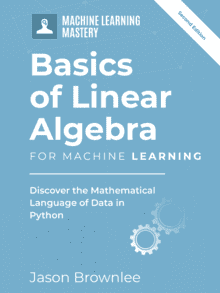Why Learn Linear Algebra for Machine Learning?
Linear algebra is a field of mathematics that could be called the mathematics of data.
It is undeniably a pillar of the field of machine learning, and many recommend it as a prerequisite subject to study prior to getting started in machine learning. This is misleading advice, as linear algebra makes more sense to a practitioner once they have a context of the applied machine learning process in which to interpret it.
In this post, you will discover why machine learning practitioners should study linear algebra to improve their skills and capabilities as practitioners.
After reading this post, you will know:
- Not everyone should learn linear algebra, that it depends where you are in your process of learning machine learning.
- 5 Reasons why a deeper understanding of linear algebra is required for intermediate machine learning practitioners.
- Where to get started once you are motivated to begin your journey into the field of linear algebra.
Kick-start your project with my new book Linear Algebra for Machine Learning, including step-by-step tutorials and the Python source code files for all examples.
Let’s get started.

5 Reasons to Learn Linear Algebra for Machine Learning
Photo by a.poll_o, some rights reserved.
Reasons to NOT Learn Linear Algebra
Before we go through the reasons that you should learn linear algebra, let’s start off by taking a small look at the reason why you should not.
I think you should not study linear algebra if you are just getting started with applied machine learning.
- It’s not required. Having an appreciation for the abstract operations that underly some machine learning algorithms is not required in order to use machine learning as a tool to solve problems.
- It’s slow. Taking months to years to study an entire related field before machine learning will delay you achieving your goals of being able to work through predictive modeling problems.
- It’s a huge field. Not all of linear algebra is relevant to theoretical machine learning, let alone applied machine learning.
I recommend a breadth-first approach to getting started in applied machine learning.
I call this approach a results-first approach. It is where you start by learning and practicing the steps for working through a predictive modeling problem end-to-end (e.g. how to get results) with a tool (such as scikit-learn and Pandas in Python).
This process then provides the skeleton and context for progressively deepening your knowledge, such as how algorithms work and eventually the math that underlies them.
After you know how to work through a predictive modeling problem, let’s look at why you should deepen your understanding of linear algebra.
Need help with Linear Algebra for Machine Learning?
Take my free 7-day email crash course now (with sample code).
Click to sign-up and also get a free PDF Ebook version of the course.
1. You Need to Learn Linear Algebra Notation
You need to be able to read and write vector and matrix notation.
Algorithms are described in books, papers and on websites using vector and matrix notation.
Linear algebra is the mathematics of data and the notation allows you to describe operations on data precisely with specific operators.
You need to be able to read and write this notation. This skill will allow you to:
- Read descriptions of existing algorithms in textbooks.
- Interpret and implement descriptions of new methods in research papers.
- Concisely describe your own methods to other practitioners.
Further, programming languages such as Python offer efficient ways of implementing linear algebra notation directly.
An understanding of the notation and how it is realized in your language or library will allow for shorter and perhaps more efficient implementations of machine learning algorithms.
2. You Need to Learn Linear Algebra Arithmetic
In partnership with the notation of linear algebra are the arithmetic operations performed.
You need to know how to add, subtract, and multiply scalars, vectors, and matrices.
A challenge for newcomers to the field of linear algebra are operations such as matrix multiplication and tensor multiplication that are not implemented as the direct multiplication of the elements of these structures, and at first glance appear nonintuitive.
Again, most if not all of these operations are implemented efficiently and provided via API calls in modern linear algebra libraries.
An understanding of how vector and matrix operations are implemented is required as a part of being able to effectively read and write matrix notation.
3. You Need to Learn Linear Algebra for Statistics
You must learn linear algebra in order to be able to learn statistics. Especially multivariate statistics.
Statistics and data analysis are another pillar field of mathematics to support machine learning. They are primarily concerned with describing and understanding data. As the mathematics of data, linear algebra has left its fingerprint on many related fields of mathematics, including statistics.
In order to be able to read and interpret statistics, you must learn the notation and operations of linear algebra.
Modern statistics uses both the notation and tools of linear algebra to describe the tools and techniques of statistical methods. From vectors for the means and variances of data, to covariance matrices that describe the relationships between multiple Gaussian variables.
The results of some collaborations between the two fields are also staple machine learning methods, such as the Principal Component Analysis, or PCA for short, used for data reduction.
4. You Need to Learn Matrix Factorization
Building on notation and arithmetic is the idea of matrix factorization, also called matrix decomposition.
You need to know how to factorize a matrix and what it means.
Matrix factorization is a key tool in linear algebra and used widely as an element of many more complex operations in both linear algebra (such as the matrix inverse) and machine learning (least squares).
Further, there are a range of different matrix factorization methods, each with different strengths and capabilities, some of which you may recognize as “machine learning” methods, such as Singular-Value Decomposition, or SVD for short, for data reduction.
In order to read and interpret higher-order matrix operations, you must understand matrix factorization.
5. You Need to Learn Linear Least Squares
You need to know how to use matrix factorization to solve linear least squares.
Linear algebra was originally developed to solve systems of linear equations. These are cases where there are more equations than there are unknown variables (e.g. coefficients). As a result, they are challenging to solve arithmetically because there is no single solution as there is no line or plane can fit the data without some error.
Problems of this type can be framed as the minimization of squared error, called least squares, and can be recast in the language of linear algebra, called linear least squares.
Linear least squares problems can be solved efficiently on computers using matrix operations such as matrix factorization.
Least squares is most known for its role in the solution to linear regression models, but also plays a wider role in a range of machine learning algorithms.
In order to understand and interpret these algorithms, you must understand how to use matrix factorization methods to solve least squares problems.
One More Reason
If I could give one more reason, it would be: because it is fun.
Seriously.
Learning linear algebra, at least the way I teach it with practical examples and executable code, is a lot fun. Once you can see how the operations work on real data, it is hard to avoid developing a strong intuition for the methods.
Do you have more reasons why it is critical for an intermediate machine learning practitioner to learn linear algebra?
Let me know if the comments below.
Where to Start in Linear Algebra?
Perhaps now you are motivated to take a step into the field of linear algebra.
I would caution you to not take a straight course on linear algebra. It is a big field, and not all of it will be relevant or applicable to you as a machine learning practitioner, at least not in the beginning.
I would recommend a staggered approach and starting with the following areas of linear algebra that are relevant to machine learning.
- Vector and Matrix Notation.
- Vector and Matrix Arithmetic.
- Multivariate Statistics.
- Matrix Factorization.
- Linear Least Squares.
I would consider this the minimum linear algebra required to be an effective machine learning practitioner.
You can go deeper and learn how the operations were derived, which in turn may deepen your understanding and effectiveness in some aspects of applied machine learning, but it may be beyond the point of diminishing returns for most practitioners, at least in terms of the day-to-day activities of the average machine learning practitioner.
Summary
In this post, you discovered why, as a machine learning practitioner, you should deepen your understanding of linear algebra.
Specifically, you learned:
- Not everyone should learn linear algebra, that it depends where you are in your process of learning machine learning.
- 5 Reasons why a deeper understanding of linear algebra is required for intermediate machine learning practitioners.
- Where to get started once you are motivated to begin your journey into the field of linear algebra.
Do you have any questions?
Ask your questions in the comments below and I will do my best to answer.








Just bought your new book.
I like the fact, that you stuck to linear algebra and neglected calculus.
You could have added a ton of calculus, but for developers, I think the ability to intuitively understand calculus is enough.
In short, as a programmer, I want to be able to code a tensor but not a chain rule. Roughly understanding a chain rule is enough (for me).
Thanks for sharing your knowledge Jason!
Thanks Franco.
Bravo, well said. Hooray for LInear Algebra. An understanding of the subject is a must! Just spent a year and a half with David Lay’s text on Linear Algebra. Read from cover to cover. Completed about 90% of the questions at the end of each chapter. WOW, now talk about fun! It REALLY was a profound experience and I have found that the knowledge gained on matrices, vectors, spaces, etc is extremely helpful in dealing with dimension reduction techniques like PCA mentioned above along with countless other big data endeavors.
Right on, well done!
Hi Jason
Thank you for your article.
Could I translate it in Arabic please?
Saad
Please do not translate my blog posts.
I explain more here:
https://machinelearningmastery.com/faq/single-faq/can-i-translate-your-posts-books-into-another-language
Začal jsem doučovat středoškoláka lineární algebru, zaujal mě nadpis tohoto článku “Proč se učit …”, abych studenta lépe získal. Student, který se učí s chutí má rychleji dobré výsledky.
Nenašel jsem jedinou větu, kterou bych studentovi opakoval, článek mohl napsat dobrý matematik, ale rozhodně ne dobrý pedagog.
Thanks for sharing your opinion.